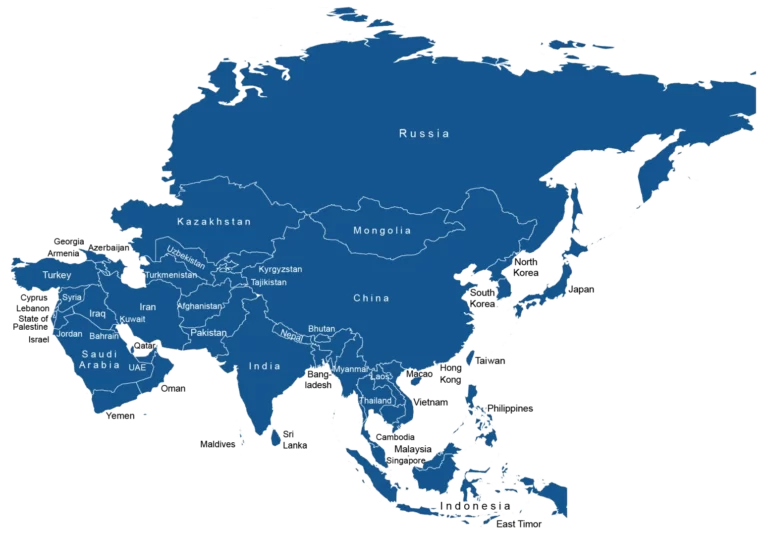About Asia
Asia is the largest and most populous continent on Earth, covering about 17.2% of the planet’s total land area. It is located in the eastern hemisphere and is bordered by the Pacific Ocean to the east, the Arctic Ocean to the north, Europe to the west, and Africa to the southwest.
Asia is home to some of the world’s earliest civilizations, including the Mesopotamian civilization, the Indus Valley Civilization, the ancient Chinese civilization, and the ancient Egyptian civilization. Throughout its history, Asia has been a melting pot of different cultures and civilizations, and as a result, it is incredibly diverse.
The continent is divided into several regions, including Central Asia, South Asia, East Asia, and Southeast Asia. Each of these regions has its own unique geography, climate, and culture. For example, South Asia is known for its lush tropical landscapes and the Himalayan mountain range, while East Asia is famous for its dense cities, advanced technology, and rich history.
Asia is also home to many of the world’s largest and most populated countries, including China, India, Indonesia, and Japan. These countries are major players in the global economy and are known for their diverse cultures, languages, and religions. Additionally, Asia is home to several important global trade hubs, such as Hong Kong, Shanghai, and Singapore.
In recent years, Asia has become increasingly important in the world, due to its rapidly growing economies, rising political influence, and expanding military presence. This has led to increased economic and political tensions between some of the continent’s major powers, such as China, India, and Japan, as well as the United States. Despite these challenges, however, Asia remains a dynamic and exciting place, full of opportunities for growth and exploration.
Physical Characteristics of Asia
- Size: Asia is the largest of the seven continents, covering an area of 44,579,000 square kilometers.
- Landscape: The landscape of Asia is highly varied and includes towering mountain ranges, sprawling deserts, vast grasslands, and dense forests.
- Climate: The climate in Asia is equally varied, ranging from tropical in the south to subarctic in the north.
- Flora: The flora of Asia is highly diverse, with unique species found in different regions of the continent.
- Fauna: Asia is home to a wide variety of wildlife, including many species of primates, cats, bears, and deer, as well as many birds and reptiles.
Geographical Location of Asia
- Latitude: Generally between 8°N and 80°N
- Longitude: Generally between 20°E and 170°E
- Hemisphere: Northern and Eastern
- Proximity to Oceans and Seas: Bordered by the Arctic Ocean to the north, the Pacific Ocean to the east, and the Indian Ocean to the south.
Historical Significance of Asia
Asia is the birthplace of several ancient civilizations, including the Mesopotamian civilization in present-day Iraq, the Indus Valley Civilization in present-day India and Pakistan, and the Chinese civilization. Over time, various empires rose and fell in Asia, including the Mongol Empire, the Ottoman Empire, and the Chinese Empire.
Economic Significance of Asia
Asia is the world’s largest and most populous continent, and it is home to some of the world’s largest and fastest-growing economies. The continent is rich in natural resources, including coal, iron ore, oil, natural gas, and a variety of minerals. The manufacturing and technology sectors are major drivers of the economies of many Asian countries, and trade and commerce are also significant.
Political Significance of Asia
Asia is the largest and most populous continent in the world, and is home to a diverse range of political systems. Some countries in Asia, such as China and North Korea, are Communist states, while others, such as India and Indonesia, are democratic republics. The borders and boundaries of Asian countries have been shaped by a variety of factors, including historical treaties, wars, and ethnic and cultural divisions. Asia has a rich history of international relations, and many countries in the region are heavily involved in global trade and commerce.
Cultural Significance of Asia
- Language: There are hundreds of languages spoken in Asia, including Mandarin Chinese, Hindi, Bengali, and Arabic.
- Religion: Asia is home to many major world religions, including Hinduism, Buddhism, Islam, and Christianity.
- Arts: Asian art is renowned for its unique styles, including traditional paintings, sculptures, and pottery.
- Literature: Asian literature includes the works of famous authors such as Rabindranath Tagore, Salman Rushdie, and Haruki Murakami.
- Traditions and Festivals: Asia is home to many vibrant festivals, including Diwali, the Chinese New Year, and the Moon Festival.
Environmental Challenges of Asia
In Asia, deforestation is a major issue in countries such as Indonesia, where large areas of rainforest are being cleared for agriculture, palm oil production, and other forms of development. This deforestation contributes to the loss of biodiversity, as well as to climate change through the release of carbon stored in the trees. Climate change is also affecting many parts of Asia, including coastal regions that are vulnerable to rising sea levels and more frequent and severe weather events.

